Have you ever wondered how to wire LED strip lights, diagram included, to achieve that perfect ambient glow in your home? Many people find themselves puzzled by the intricacies of LED strip light installation, often overwhelmed by the technical details and potential pitfalls.
Common challenges include selecting the right type of LED strip, understanding the power supply requirements, and ensuring a safe and secure installation. Misconceptions abound, such as the belief that wiring LED strip lights is a task best left to professionals, when in fact, with the right guidance, anyone can master it.
The benefits of learning how to wire LED strip lights are manifold. Not only do they enhance the aesthetic appeal of any space, but they also offer energy efficiency and versatility in design. Whether you’re looking to create a cozy reading nook or a vibrant entertainment area, tunable white LED strip lights can make it happen.
In this guide, we’ll cover everything from choosing the right materials to step-by-step wiring instructions, complete with a detailed diagram. You’ll also learn about essential safety precautions and troubleshooting tips.
Ready to transform your space with the magic of LED strip lights? Let’s dive into the details and illuminate your home with confidence and style.
Understanding Voltage Drop
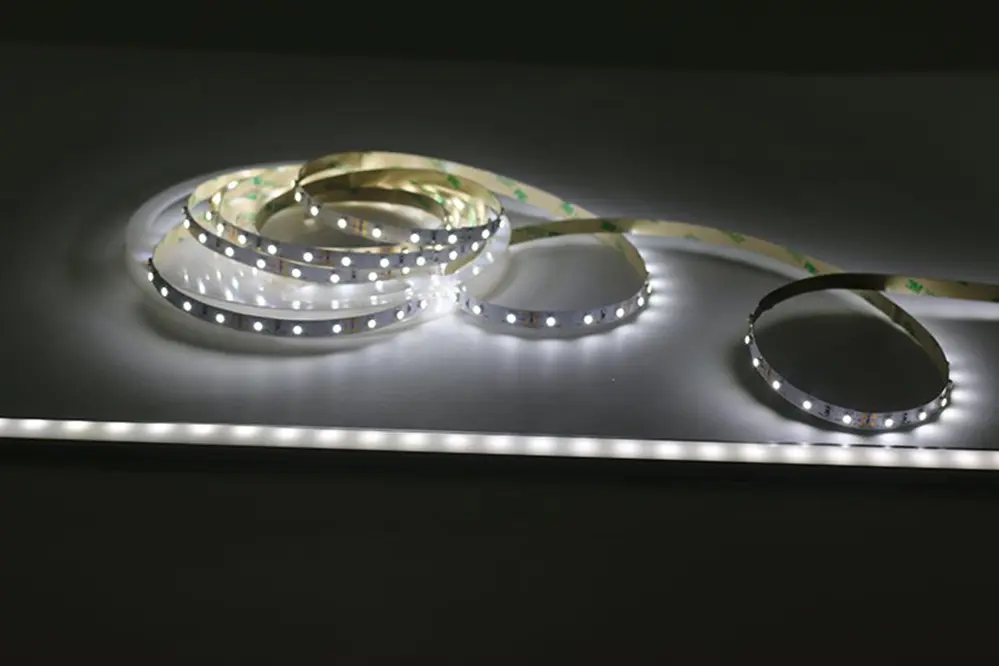
Voltage drop is an essential concept to grasp when wiring LED strip lights.
In essence, voltage drop refers to a decrease in electrical voltage along the strip length of the LED strip. As the current travels further along the strip, the resistance of the wiring causes a reduction in voltage, impacting the brightness of the LEDs and potentially leading to uneven lighting.
For instance, an LED strip of considerable length will experience more voltage drop compared to a shorter one. Understanding this phenomenon ensures that the planned length and power supply will maintain the desired luminous intensity across the entire strip, thereby achieving consistent illumination.
To mitigate the effects of voltage drop, it is crucial to use an appropriate power supply and to possibly segment the LED strip into shorter, interconnected sections. This approach not only enhances the brightness but also prolongs the lifespan of the LEDs, safeguarding the initial investment and optimizing the visual appeal.
Parallel Connections Explained

Parallel wiring keeps voltage constant.
When wiring LED strip lights, parallel connections can be your best friend. This wiring technique involves connecting multiple LED strip segments to the same power source, ensuring that each segment receives an equal voltage distribution. Consequently, it mitigates the issue of voltage drop, delivering uniform brightness across all strips connected in parallel.
Such a setup is easy to implement.
In a typical parallel connection, each LED strip segment is linked directly to the power supply – not to other segments. This method ensures that the luminescence of one strip is not compromised by the others, leading to a balanced, consistent lighting effect.
This connection method also offers operational advantages. By isolating each strip to its own dedicated route to the power source, parallel connections enhance system reliability. Should one segment fail, the others continue to function without disruption, thereby assuring longevity and performance consistency.
Ultimately, parallel connections are pivotal for achieving flawless illumination in sophisticated lighting projects. By understanding and applying parallel wiring principles, one can bring their LED lighting visions to vibrant fruition, ensuring brilliance in both execution and effect.
Utilizing PWM Amplifiers
Pulse Width Modulation (PWM) amplifiers optimize the performance of LED strip lights.
These amplifiers, by modulating power in a pulse-like manner, enhance the consistency and efficiency of the lighting. They allow for precise light control, ensuring that LED strips maintain their desired luminosity levels even when extended over long distances. This is particularly useful in large-scale installations where uniform brightness is paramount.
Furthermore, PWM amplifiers facilitate a smoother dimming experience. In traditional methods, LED lights may flicker or experience uneven brightness during dimming. However, with PWM amplifiers, the dimming process is more seamless, preserving the integrity and aesthetic appeal of the lighting.
Thus, integrating PWM amplifiers into your LED strip light setup not only boosts the overall performance and reliability but also fortifies the quality of the lighting experience with a pwm amplifier. With their robust capabilities, these amplifiers are an indispensable component in achieving professional-grade illumination, transforming spaces with consistent and captivating light.
Wiring Single Color LED Strip Lights
Wiring single color LED strip lights demands precision and attention to specifications. One must gather the essential tools and equipment before commencing, such as connectors, wire strippers, a compatible power supply, soldering tools, and adhesive for secure mounting.
To start, ensure the LED strip’s polarity is accurately identified (positive and negative) to prevent wiring mishaps. Carefully attach the positive wire from the power supply to the positive terminal of the strip, then repeat for the negative wire.
Using the provided “how to wire LED strip lights diagram” ensures adherence to the correct wiring protocol.
Non-Dimmable Drivers

Non-dimmable drivers provide a consistent level of power to LED strip lights, ensuring reliable illumination. Their architectural design focuses on delivering uncompromised performance devoid of fluctuations or dimming features.
In certain settings such as workspaces or industrial environments, the steady output of non-dimmable drivers proves particularly advantageous. They are excellent for maintaining uniform brightness levels critical for accurate work.
Non-dimmable drivers guarantee the LED lights’ longevity by preventing power surges that can lead to premature failure.
When selecting a non-dimmable driver, it is imperative to verify it matches the voltage, current requirements, and current rating of the LED strip lights. Their proliferation in applications where consistent light is paramount has cemented their reputation as a dependable solution for uninterrupted lighting.
Dimmable Drivers
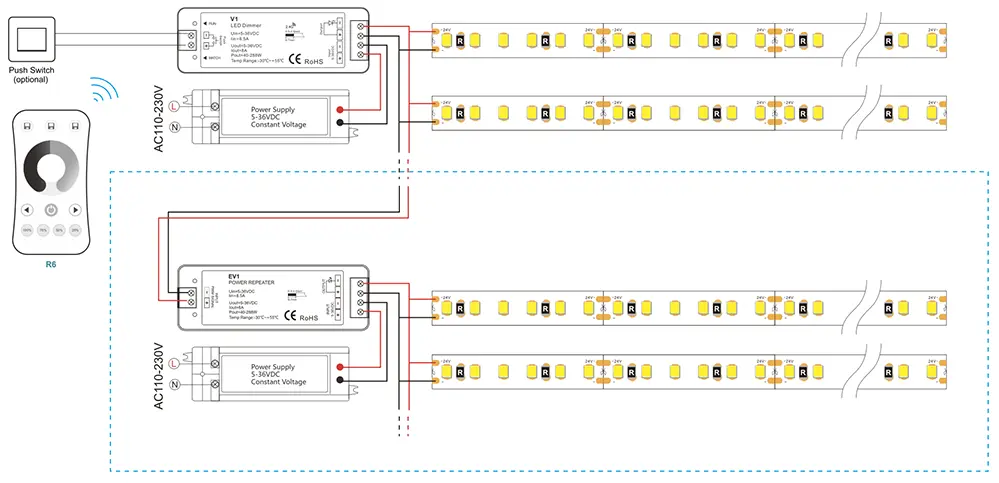
Dimmable drivers offer flexibility in adjusting the brightness levels of LED strip lights. They are essential for creating customizable lighting environments.
- Versatility: Dimmable drivers can cater to various ambiance needs, from cozy atmospheres to brightly lit areas.
- Energy Efficiency: By dimming the lights, energy consumption is significantly reduced, leading to cost savings.
- Extended Lifespan: Controlled brightness reduces wear and tear on the LEDs, enhancing their longevity.
- User Control: Incorporate remote controls and smart home integration for effortless light adjustments.
These drivers are ideal for residential settings, where one might desire varying intensities of light throughout the day.
Choosing the right dimmable driver involves ensuring compatibility with the LED strip lights and the dimming technology used.
Their ability to offer personalized lighting, conserve energy, and extend product life makes dimmable drivers an attractive option.
LED Controllers
LED controllers empower users with customization options to enhance their lighting experience significantly.
- Wired Controllers: Reliable and straightforward, providing direct connection and consistent performance.
- Wireless Controllers: Offer remarkable flexibility and ease of use, ideal for modern setups.
- Smart Home Integration: Seamlessly connects with smart home systems, enabling voice control and automation.
- Color Change Controllers: Allows dynamic color shifts and mood setting with RGB and RGBW LEDs.
These controllers can convert a mundane space into a visually stimulating environment effortlessly.
Choosing the right controller depends on the desired functionality and complexity of the lighting scheme.
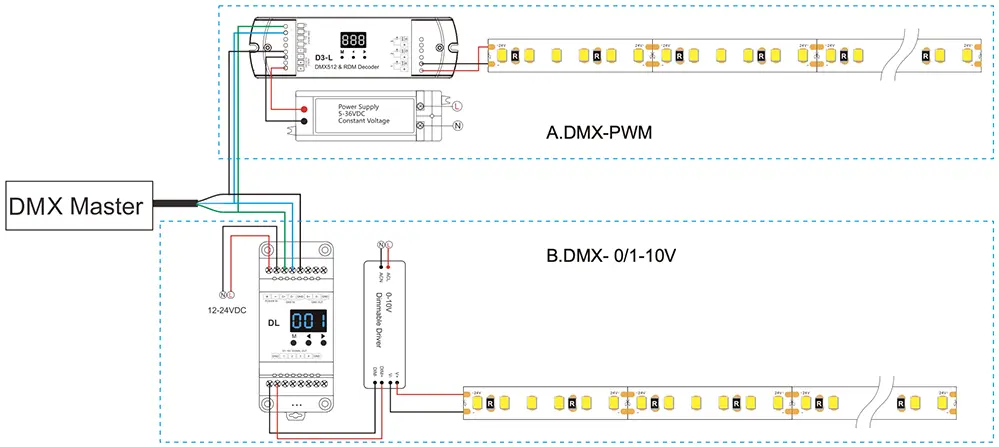
Wiring Tunable White LED Strip Lights

Wiring tunable white LED strip lights offers the advantage of adjusting correlated color temperature to fit various moods and tasks. These strips feature both warm white and cool white LEDs, allowing users to shift from cozy, ambient lighting to bright, task-oriented illumination.
Accessing their dual-color capability requires connecting them to a compatible controller that handles color temperature adjustments, maximizing the versatility of their lighting setup.
Dimmable Drivers
Dimmable drivers play a crucial role in enhancing the versatility of LED strip lights.
Recent years, technological advancements in dimmable drivers have revolutionized lighting solutions by offering gradual luminosity control. These drivers help create customized lighting atmospheres.
Today, it’s not just about turning lights on or off; it’s about tailoring the brightness exactly to one’s preference. Dimmable drivers extend the functionality of LED strip lights significantly.
Users can dictate the ambiance of their space, whether they want the lights to be bright for focus or dimmed for relaxation. Such flexibility is essential for creating diverse, adaptable environments.
Incorporating dimmable drivers within their designs allows users to maximize their lighting setups’ potential.
LED Controllers
LED controllers add significant functionality to LED strip lights.
These essential devices give users the power to manage their lighting easily. For those looking to modify the visual experience of their environment, controllers provide an essential bridge for transforming ideas into illuminating reality. Controllers come in various forms, from simple remote controls to sophisticated smartphone apps, allowing for unparalleled customization.
They manage brightness, colors, and dynamic effects.
Leveraging an LED controller is simple – users can connect their strip lights to it, ensuring the proper power supply is in place. This connection opens up a vast array of lighting possibilities, enabling effortless scene setting and ambiance creation.
Incorporating an advanced LED controller can significantly enhance the efficiency and aesthetic appeal of lighting projects, moving beyond mere illumination. This investment in controllers ultimately results in spaces that resonate with light, emotion, and personalized ambiance, inspiring any who step into their glow.
DMX512 Decoder
The DMX512 decoder serves a pivotal function.
These devices translate the DMX512 digital signal into PWM signals. This process enables the precise control of individual LEDs within a strip, offering users the opportunity to create sophisticated lighting environments. Consequently, they are an indispensable component in professional lighting designs where exact control over color and intensity is paramount.
DMX512 decoders are easy to configure.
They interface seamlessly with a central DMX controller, which orchestrates the lighting effects. Users have control over an extensive palette of vibrant hues and intricate lighting sequences.
When opting to include a DMX512 decoder in their setup, they gain access to expanded control capabilities and nuanced customizations, enhancing not only the performance but also the aesthetic value of their spaces. Utilizing these decoders empowers them to synchronize lights with other multimedia elements, forging immersive, multi-sensory experiences.
Wiring RGB LED Strip Lights
Wiring RGB LED strip lights involves connecting the power supply and controller to the RGB strip itself, ensuring that the red, green, and blue channels can be independently managed. The essential components include the LED strip, power supply, RGB controller, and connectors, all working in tandem to deliver vibrant, customizable lighting.
Proper connections, a reliable power supply, and a thorough understanding of the wiring diagram, considering the led density, are critical to achieving the desired lighting effects. By following the wiring guide carefully, users can unlock limitless possibilities in color and vivid lighting displays.
Dimmable Drivers
Dimmable drivers are a pivotal component in the realm of LED lighting. These devices enable the fine-tuning of brightness and color temperature with tunable white technology.
Recent years, dimmable drivers, a significant advancement in LED technology, have allowed users to adjust light intensity with ease and precision. This has amplified the usability and energy efficiency of LED installations.
Yes, it’s not just about switching lights on and off; it’s about creating a symphony of illumination that aligns with their ambiance needs. With dimmable drivers, users transform static lighting into a versatile lighting experience.
Whether they seek to brighten the room or create a subtle glow, dimmable drivers offer flexibility that is unmatched in the world of LED lighting. From rush-hour intensity to serene twilight, every mood is attainable.
Incorporating these drivers into their wiring configuration elevates the artistry and functionality of any lighting setup.
LED Controllers
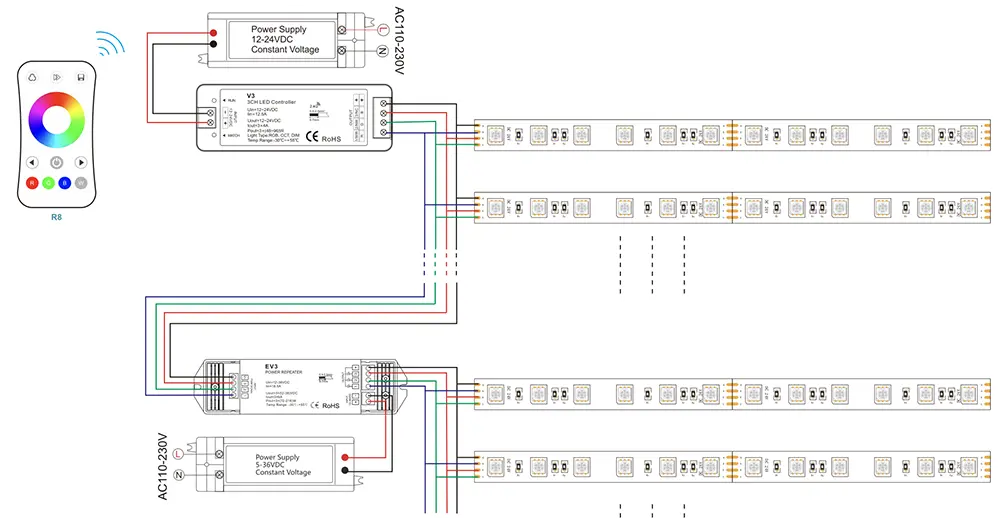
LED controllers are essential for managing the lighting effects of LED strip lights, offering both versatility and creativity.
- RF Controllers: Utilize radio frequency to control LED strips without direct line-of-sight.
- WiFi Controllers: Allow integration with smart home systems for remote access and programming.
- Bluetooth Controllers: Enable convenient control via smartphone apps within proximity.
- DMX Controllers: Provide professional-grade control for intricate lighting designs and synchronized performances.
- IR Controllers: Use infrared signals for basic adjustments and require direct line-of-sight.
With a suitable controller, users can customize lighting patterns, intensities, and colors to perfectly match their preferences.
These devices bring a new dimension to LED strip lighting, ensuring a dynamic and engaging visual experience.
DMX512 Decoder
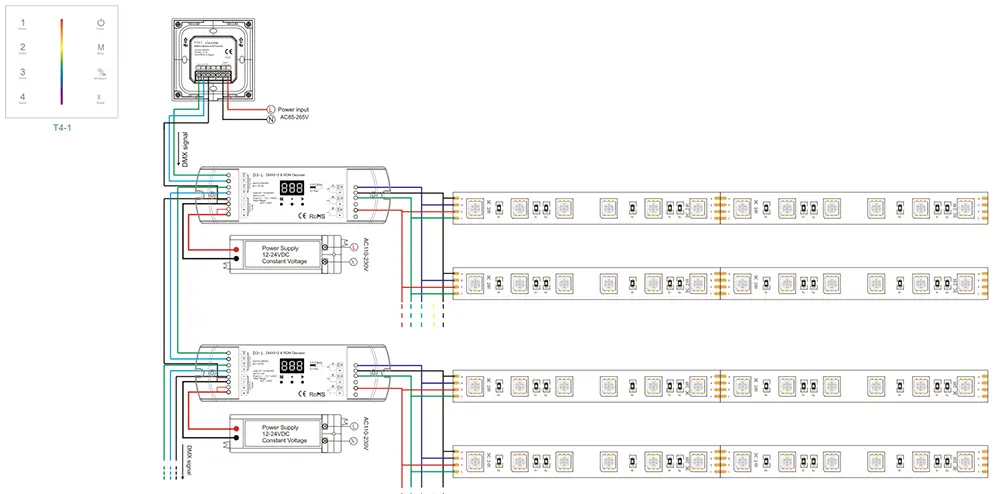
A DMX512 decoder plays a crucial role in professional lighting setups, ensuring precise control and synchronization of LED strip lights.
This decoder, often utilized in stage lighting and architectural installations, translates DMX512 protocol signals into commands that LED strip lights can understand. By integrating this decoder, users achieve an extraordinary level of control over their lighting displays, crafting breathtaking scenes that can be timed to music or other theatrical elements.
Functionally, the DMX512 decoder converts the digital signals from a DMX controller into analog signals required by LED strip lights, often using a PWM amplifier to achieve precise control. This allows multiple light fixtures to be managed simultaneously with consistent accuracy, enhancing the overall visual impact.
For advanced users, a DMX512 decoder represents an indispensable tool in the pursuit of lighting brilliance. By integrating this technology, they can transform their environments with dazzling light shows and immersive atmospheres, pushing the boundaries of what is possible in the world of illumination and design.
Wiring RGBW LED Strip Lights
Wiring RGBW LED strip lights involves connecting red-green-blue-white (RGBW) lights to their respective channels’ terminals, thus enhancing the lighting experience.
To do so, users connect each color’s wire to the corresponding terminal (R, G, B, W) to ensure an optimal display. It is crucial to follow the wiring diagram to avoid mismatches and ensure perfect synchronization of colors and brightness.
Both “S+” and “S-” terminals should be connected to the ‘signal ground’.
Dimmable Drivers
Dimmable drivers empower users to control the brightness of their LED strip lights effortlessly.
- Compatibility: Ensure that dimmable drivers are compatible with the chosen LED strips.
- Wattage Capacity: Select a driver with an appropriate wattage capacity to prevent overload.
- Wiring: Follow the wiring diagram meticulously to connect the driver accurately.
- Controller Options: Choose from a variety of dimming controllers, including wall switches and remote systems.
Using dimmable drivers offers flexibility and dynamic lighting control.
Their installation is straightforward yet demands attention to detail to optimize performance.
LED Controllers
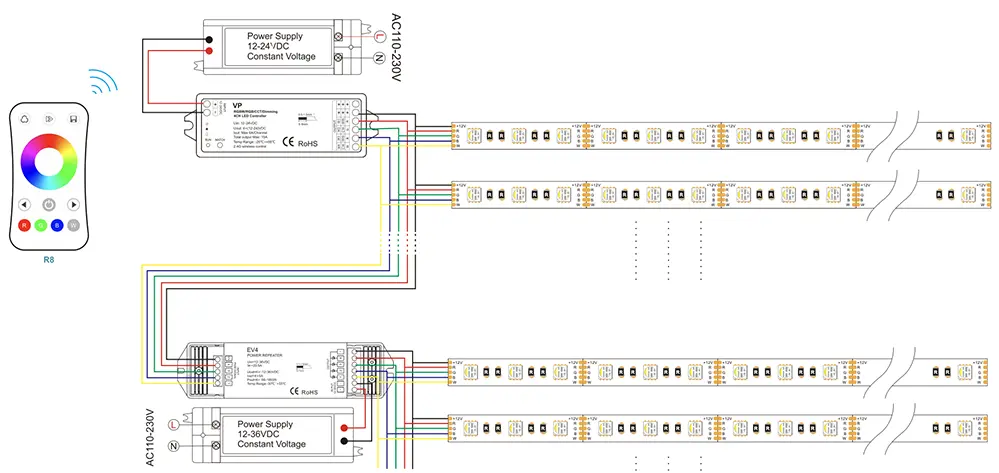
LED controllers serve as vital components in managing the various functionalities of LED strip lights, such as color, brightness, and effects.
- Controller Types: Choose between wired or wireless controllers based on convenience and application.
- Compatibility: Ensure the controller is compatible with the specific LED strip model.
- Input Voltage: Verify that the input voltage of the controller matches the LED strip requirements.
- Control Method: Select controllers with desired control methods, like RF, IR, or Bluetooth.
- Installation: Follow the wiring diagram precisely for proper installation.
Utilizing LED controllers enhances the customization and functionality of lighting systems.
Selecting the right controller is crucial for optimal performance and user satisfaction.
Integrating advanced controllers, such as a PWM amplifier, can transform the ambiance and adaptability of spaces dramatically.
DMX512 Decoder
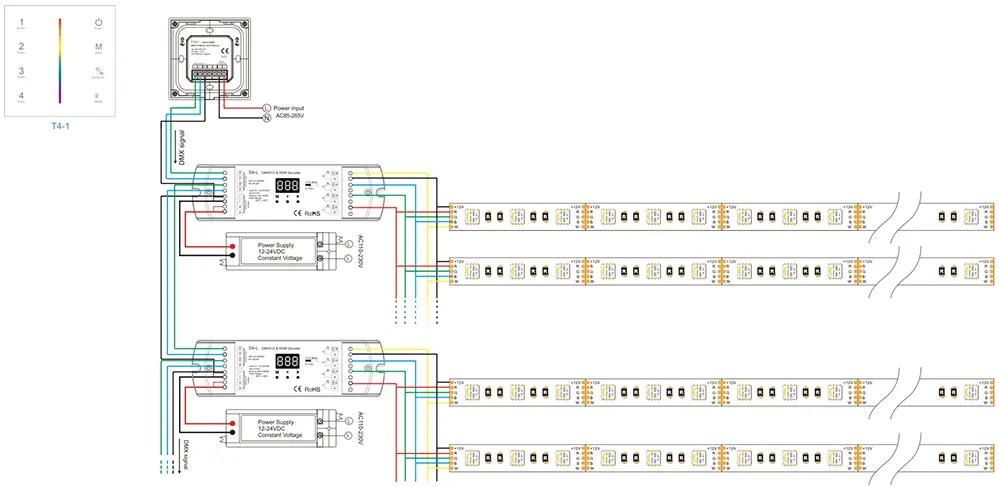
A DMX512 decoder represents an advanced solution for controlling LED strip lights with ultimate precision.
Introduced in 1986, DMX512 decoders are a widely recognized standard in the entertainment industry. They allow for complex lighting setups through digital communication.
Connecting a DMX512 decoder to an LED strip light system offers unparalleled customization. This integration enables users to program intricate lighting sequences and ensure consistent performance.
Within the domain of LED lighting, these decoders provide a robust control mechanism. It’s crucial to use a DMX controller compatible with your specific LED strip to unlock the full potential of your setup.
The sophistication of DMX512 decoders elevates lighting projects to new heights, demonstrating the synergy between technology and creativity.
Wiring RGBCCT LED Strip Lights
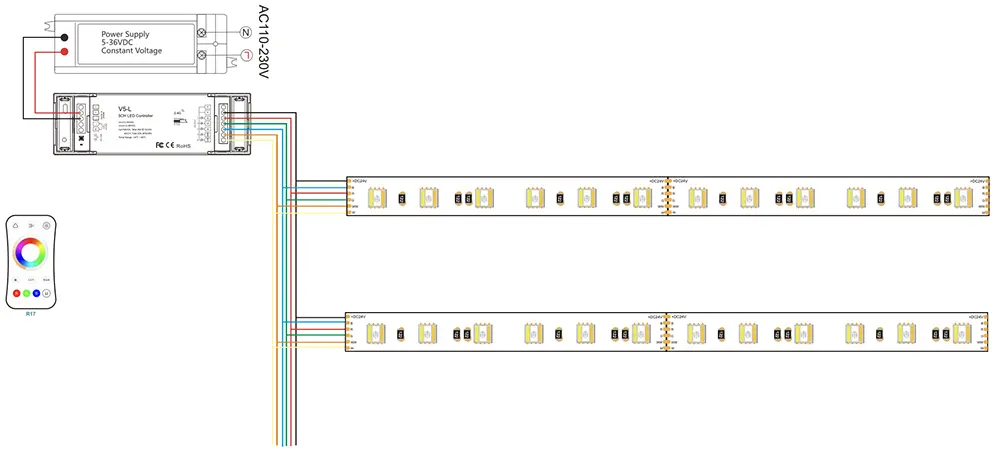
Wiring RGBCCT LED strip lights, a spectrum of technology innovation, begins with a clear understanding of the wiring diagram included. Proper connection of the RGB (red, green, blue) and CCT (correlated color temperature) leads allows for an unparalleled customization experience, balancing vivid colors with precise white light control. Utilizing a compatible controller and ensuring all connections are secure, one can transform any environment into a harmonious blend of dynamic and ambient lighting, opening a world of possibilities for both residential and commercial applications.
Dimmable Drivers
Dimmable drivers significantly enhance the functionality of LED strip lights, allowing precise control over light intensity.
For the advanced reader, installing dimmable drivers is a straightforward process involving certain key steps: selecting an appropriate driver, connecting the driver to the power source, and linking the LED strips to the driver. This configuration not only supports a varied lighting ambiance but also contributes substantially to energy efficiency by tailoring light usage to specific needs.
Effectively, these drivers become an essential component in the overall design, offering seamless integration within diverse settings. Whether it’s for a tranquil residential environment or a dynamic commercial space, the ability to adjust lighting accordingly enriches the user experience and optimizes operational efficiency.
In conclusion, incorporating dimmable drivers into LED strip lighting systems epitomizes intelligent lighting solutions. Their adaptability, combined with user-friendly installation procedures, empowers individuals to create visually captivating environments. As technology advances, such innovations will continue to evolve, reiterating the endless potential of LED lighting systems in crafting both functional and aesthetically pleasing spaces.
LED Controllers
LED controllers are essential for managing the lighting settings and effects of LED strip lights, providing users with aesthetic flexibility and control.
- Remote Controllers: Allow for wireless adjustments of brightness and colors.
- Wi-Fi or Bluetooth Controllers: Enable control via smartphone apps or smart home systems.
- DMX Controllers: Suitable for complex lighting setups, commonly used in professional applications.
- Wall-Mounted Controllers: Offer a more permanent and easily accessible control option.
Choosing the right controller depends on the specific needs and complexity of the lighting project.
These controllers enhance the user experience by simplifying the customization of lighting effects, adding convenience and versatility to any setting.
DMX512 Decoder
The DMX512 decoder, integral to professional lighting setups, ensures precise control over complex configurations and stunning light displays.
By interpreting DMX512 signals into PWM signals for LED strips, it simplifies the process of creating synchronized and dynamic lighting effects. These decoders are vital for large-scale installations such as theaters, concerts, and architectural lighting, requiring robust and reliable control mechanisms. Consequently, they not only enhance the visual impact of the lighting but also ensure that the system operates smoothly and efficiently.
Typically, these decoders connect seamlessly to DMX controllers, facilitating easier integration and manipulation of intricate lighting patterns. Users can adjust the brightness, color, and on-off sequences of each LED strip, enabling the creation of virtually any desired lighting effect with precision and finesse.
Moreover, the functionality of DMX512 decoders extends to supporting various software platforms, ensuring compatibility and ease of use in diverse projects. This opens up a world of possibilities for lighting designers, empowering them to push the boundaries of creativity while maintaining superior control and reliability over their LED lighting systems.
Wiring Addressable LED Strip Lights
Wiring addressable LED strip lights requires a nuanced understanding of electrical connections, as these lights can achieve complex visual effects. Typically, addressable LED strips feature a data line, a clock line, and power lines. Connecting these lines correctly ensures that each LED can be independently controlled, allowing for sophisticated animations and patterns to be displayed. It is essential to use a reliable power supply and a compatible microcontroller to manage data signals effectively, safeguarding against potential issues and achieving optimal performance.
SPI Addressable LED Strips
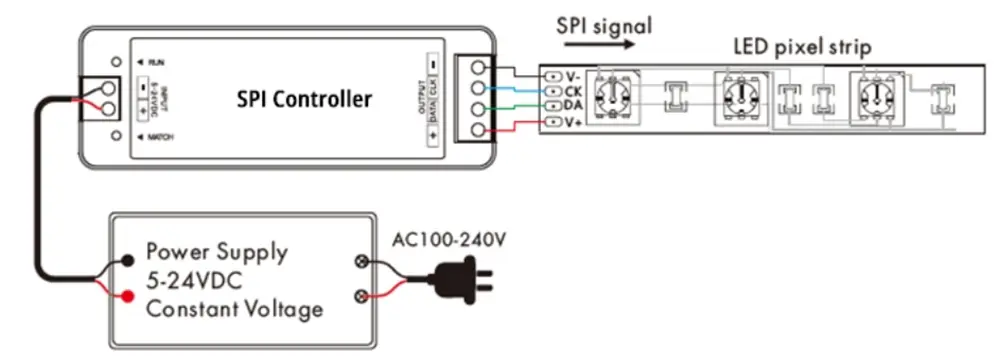
SPI (Serial Peripheral Interface) addressable LED strips offer unparalleled control and flexibility for complex lighting designs.
- Preparation: Gather necessary tools and materials, including the LED strip, microcontroller, wires, and a power supply.
- Connection: Connect the power lines (V+ and GND) of the LED strip to the corresponding terminals on the power supply.
- Data Line: Connect the data line (DI) of the LED strip to the designated output pin on the microcontroller.
- Clock Line: Link the clock line (CI) from the LED strip to the appropriate clock output pin on the microcontroller.
- Testing: Power up the system and upload the control program to the microcontroller to test the LED strip.
The successful wiring of SPI addressable LED strips allows for individual LED control.
This individual control enables intricate animations and dynamic lighting effects.
Proper connection and testing ensure reliable and brilliant performance.
DMX512 Addressable LED Strips
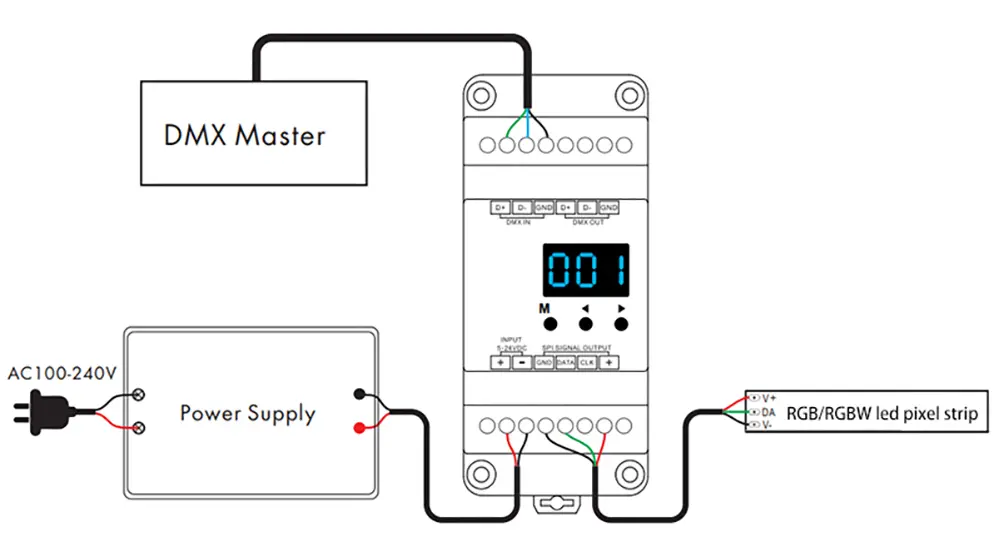
DMX512 addressable LED strips provide extraordinary precision in lighting control across extensive installations.
Since 1986, DMX512, a standard communication protocol, orchestrates digital networks used primarily for stage lighting and effects.
Today, it’s not just reserved for theater or concerts; residential and commercial scenery have also embraced the unparalleled synchronization and control options DMX512 offers.
Incorporating DMX512 into LED strip lighting involves setting unique addresses for each fixture, ensuring that one can achieve remarkable pinpoint accuracy and creative effects synchronization.
This synergy between technology and creativity opens up limitless opportunities in lighting design.
Wiring High Voltage AC LED Strip Lights

High voltage AC LED strip lights, unlike their low voltage DC counterparts, offer greater flexibility and length without the need for extensive power supplies or converters.
To begin, it is imperative to understand that high voltage AC LED strip lights require a specific wiring approach. This approach involves connecting the strips directly to an AC power source, typically ranging from 110 to 240 volts, ensuring a seamless integration into existing infrastructure. One should refer to the manufacturer’s wiring diagram included to ensure all connections are accurately made.
Notably, these strip lights feature an internal rectifier to convert AC to DC, rendering them simple to install. Consultation of the detailed wiring diagram included is crucial, as it guides users through the process, identifying the correct polarity and connection points to avoid potential hazards.
Furthermore, one must prioritize safety by incorporating necessary safeguards such as an inline fuse, GFCI outlet, and proper insulation to prevent electrical shocks. With meticulous adherence to the provided wiring diagram and safety measures, individuals can successfully wire high voltage AC LED strip lights, achieving a stunning and efficient lighting solution tailored to their needs. This successful wiring opens the door to a myriad of lighting projects, characterized by ease and brilliance.
Conclusion
Successfully wiring LED strip lights is a transformative and achievable task with precision and patience. The included diagram is essential for guidance. Adhering to guidelines ensures safety and efficiency, while incorporating safeguards minimizes hazards. This guide empowers individuals to achieve professional-quality results and confidently undertake advanced lighting projects, harmonizing functionality with aesthetics. Ultimately, mastering this skill illuminates spaces and encourages further exploration of technological intricacies.
For those seeking expert assistance or high-quality products, contacting Unitop, a professional Chinese manufacturer of LED strip lights and LED neon strips, is highly recommended. Unitop’s extensive experience and dedication to excellence ensure that customers receive top-tier products and support. By partnering with Unitop, individuals can confidently embark on their lighting projects, knowing they have access to reliable and innovative solutions. Embrace the opportunity to transform spaces with the finest LED technology from a trusted industry leader.





